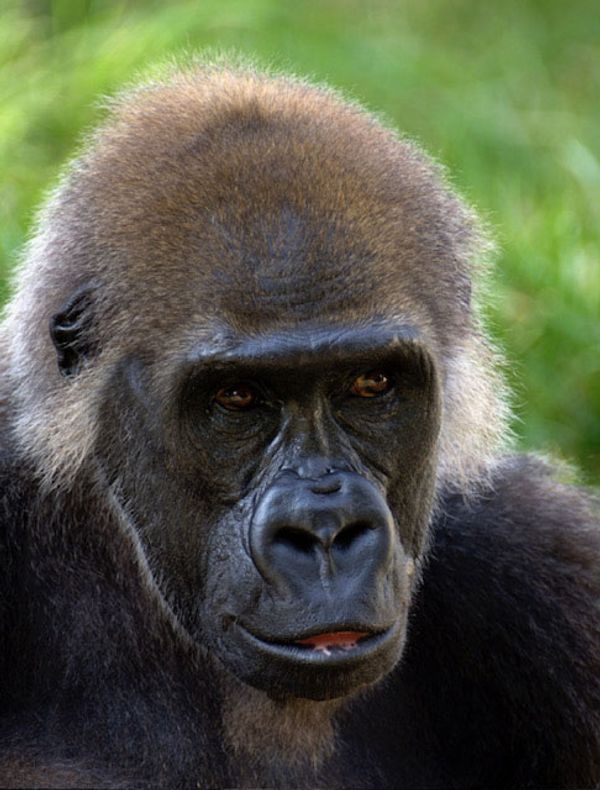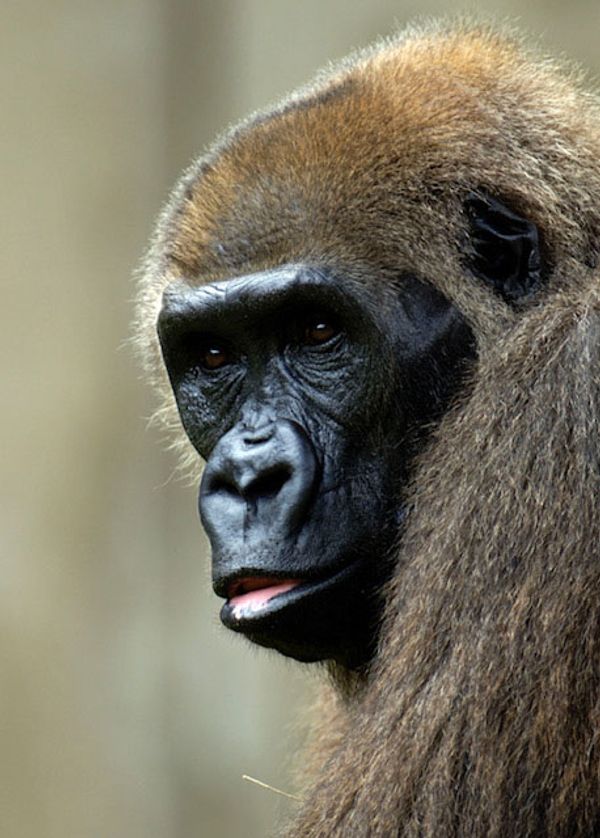There’s a lot we don’t know about gorillas. This is due to the lack of legal dead gorillas to dissect. And that means many details of our shared family tree remain unclear. For instance, we used to believe that if you look at all the primates, you’d see a gradual increase in the complexity of the lower facial muscles — important in human speech and facial expressions — as you moved from primates that are closer to our common ancestors, like the loris, say, to the Great Apes and humans.
But scientists haven’t had much of a chance to see for themselves where gorillas actually fit in this supposed spectrum. Now science — and a gorilla named Lia — may be shedding light on a question that’s more complex than it sounds.
It’s for good reasons, ethically and conservation-wise, that it’s so rare for anatomists to have a dead gorilla you can legally dissect. Despite this essential restriction, it does unfortunately slow the progress of scientific understanding. As anatomist Anne Burrows, at Duquesne University, puts it in relation to all primates, “It’s not like you can go to the grocery store and pluck a head off the shelf. They are very rare and difficult to come by.”
So an anatomy lab came up with a plan and reached out to several zoos. Fast forward: Lia the Gorilla lived a good life in a zoo before dying of a heart attack, at which point the zoo contacted the researchers. As a result, anatomists Assaf Marom and Liat Rotenstreich, at the Israel Institute of Technology, were able to fill in some gaps in our knowledge of the evolution of orofascial (lower facial) muscles in primates. Other body parts went to scientists at a different institution so as to make maximal use of this rare donation. The results were published in The FASEB Journal in 2023.
 Lia the Gorilla (Photo courtesy of Tibor Jäger)
Lia the Gorilla (Photo courtesy of Tibor Jäger)
“One of the most important things we told ourselves that we have to do is to dissect the facial muscles, because in the literature there is hardly any information on facial architecture in gorillas,” Dr. Marom, also a medical doctor, told Salon in a video interview, explaining that they had to go back to the 19th century to find previous work on the subject.
"In the literature there is hardly any information on facial architecture in gorillas."
“Facial expressions are a very appealing topic because they present an intersection of neurology and psychology anatomy and of course neuroanatomy,” Marom said, “because all of these actions of the muscles of the face are controlled of course by the brain. Because facial expressions are perceived as something that is intended for another to receive and to interpret, they also have some latent mind-body problem.”
That is, they raise questions about the relationship between the physical body and the mind, emotions or consciousness. In a gradual undermining of the idea that the lower facial muscles simply follow a spectrum from ancestral to more derived groups of primate, more recent findings suggest that rather than a spectrum of increasing complexity, the differences we see among primates reflect their specialization for different niches.
Want more health and science stories in your inbox? Subscribe to Salon's weekly newsletter Lab Notes.
The lower face in primates is chock-a-block with muscles that enable our pie holes to carry out a wide range of functions – like respiration, the suckling characteristic of all mammals, and – in a later adaptation of these muscles, which create negative pressure in the oral cavity to enable suckling, facial expressions and speech.
In particular, Marom and his team looked for a modiolus, a tendon-like structure at the corner of the mouth where many muscles insert, allowing for manipulation of the mouth, and at the SMAS (superficial musculoaponeurotic system), a layer of connective tissue prominent in humans that may give greater muscular control over the dermis, the middle layer of skin that supports the epidermis, the part you see, giving us an unparalleled range of facial expressions.
Humans are fatheads, and gorillas, it seems, are not.
As it turns out, the careful dissection of Lia’s face – by Rotenstreich, an MD-PhD student – and comparison with human and chimpanzee facial musculature reveals gorillas to be a kind of intermediary species between humans and chimps and the other primates. The gorilla lacks a modiolus, and its SMAS lacks the fatty deposits characteristic of the human SMAS. Humans are fatheads, and gorillas, it seems, are not. In general, these and other findings of more primitive (or ancestral) characteristics in the gorilla reflect molecular findings of evolutionary relationships, which do generally put gorillas in a separate branch – or clade – from chimpanzees, bonobos and humans.
The gorilla research in fact built on Burrows’ earlier finding that in lower primates or prosimians like lorises and lemurs, the area of greater complexity lies near the ear, while in higher primates, the area of fascial musculature complexity has shifted to the oral cavity – the mouth region. Burrows’ work further stressed understanding the ecological context – integrating what we learn about facial anatomy through dissection with what is observed about the behavior of animals in their natural environment.
 Lia the Gorilla (Photo courtesy of Tibor Jäger)
Lia the Gorilla (Photo courtesy of Tibor Jäger)
The gorilla, for example, needs strong muscles near the ear to chew fibrous vegetable matter, while the chimpanzee uses its incisors to bite into tasty fruit. These differences can influence the musculature around the mouth. Likewise, if your species specializes in social communication, the musculature might reflect that.
Other researchers, like evolutionary neurologist Chet Sherwood at George Washington University, further complement the work of anatomists like Marom and Burrows by studying relevant structures in the brain. In one review article, he notes that unlike chimpanzees and humans and orangutans, gorillas don’t seem to recognize themselves in the mirror, while chimpanzees, bonobos and gorillas, but not orangutans, can follow a human researcher’s line of sight to see what they’re looking at, and chimpanzees, bonobos and gorillas are all able to use gestures to communicate intention. In the same article, he notes that all the great apes show some dominance of the left brain hemisphere in regions associated in humans with language
Each of these findings helps us inch forward in our understanding of the facial and corresponding brain structures found in the last common ancestor of the great apes, or the last common ancestor of just chimps, bonobos, gorillas and humans, or of chimpanzees, bonobos and humans alone.
“The evolution of the brainstem connectome is what enables these intricate functions, and in humans — this is what enables speech,” Marom explained.
It’s actually not yet clear whether or not chimpanzees have a modiolus, as there are conflicting reports among the incredibly few dissections that have been done, although from Dr. Burrows’ dissections she says that most appear to have it (there is substantial individual variation in where muscles attach in this incredibly complex area of the face).
As shown by 19th century neurologist Guillaume Duchenne, a correspondent of Charles Darwin, it is the eye muscles that reveal genuine expression of the emotion we associate with the human smile. Still, the modiolus and the SMSH are important in the kind of communication at which humans excel.
We need your help to stay independent
“Isn’t it fascinating,” Marom said, returning to the mind-body problem, “that just by looking at someone’s face, such a small portion of the face is moving so delicately and you will easily gain a window into the person’s inner world. And you know something about what they’re feeling and what they think and whether they are pleased or more upset or annoyed by something that you said or by your behavior.”
This leaves us with work to do if we want to find out when this structure – the modiolus – evolved in primates, and thus when in our evolution we acquired the musculature, and perhaps the corresponding brain structures, for things like joyful smiles, speech and jokes. If indeed chimpanzees and humans have a modiolus but, as Marom and Rotenstreich have shown, gorillas don’t, this would mean that this unique aspect of facial architecture evolved after our shared ancestors diverged into Hominini (chimpanzees, bonobos, humans and extinct humans like Neanderthals) and Gorillini groups (gorillas and extinct gorilla-like Great Apes).
In fact, we might hope for more zoo and researcher collaborations like this one, which help us map out our primate family tree, while shedding light on such profound aspects of our existence as how we intuit what others are feeling –– all without causing harm to beautiful gorillas, like Lia.
Read more
about human evolution



Shares